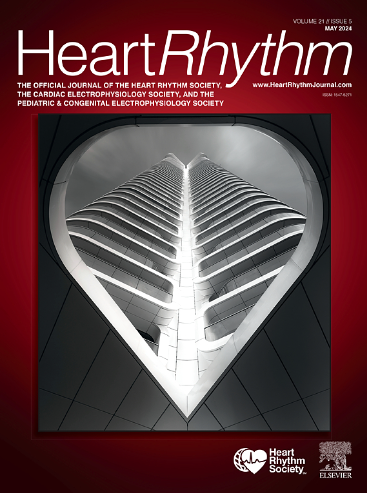Conduction system pacing associated with reduced heart failure hospitalizations and all-cause mortality compared with traditional right ventricular pacing in the Medicare population
IF 5.6
2区 医学
Q1 CARDIAC & CARDIOVASCULAR SYSTEMS
引用次数: 0
Abstract
Background
Conduction system pacing (CSP) has emerged as an alternative therapy to traditional right ventricular (RV) pacing. However, most CSP studies reflect small cohorts or single-center experience.
Objective
This analysis compared CSP with dual-chamber (DC) RV pacing in a large, population-based cohort using data from the Micra Coverage with Evidence Development study.
Methods
Medicare administrative claims data were used to identify patients implanted with a DC RV pacemaker. Lead placement data from Medtronic’s device registration system identified patients treated with CSP (n = 6197) using a 3830 catheter–delivered lead or DC RV (non–3830 lead, non–CSP placement; n = 16,989) at the same centers. CSP patients were stratified into left bundle branch area pacing (LBBAP; n = 4738) and His bundle pacing (HBP; n = 1459). Incident heart failure hospitalizations, all-cause mortality, complication rates, and reinterventions at 6 months were analyzed.
Results
CSP patients with a 3830 catheter–delivered lead experienced significantly lower rates of incident heart failure hospitalization (hazard ratio [HR], 0.70; P = .02) and all-cause mortality at 6 months compared with DC RV patients (HR, 0.66; P < .0001). There was no difference in chronic complications (HR, 0.97; P = .62) or need for reintervention (HR, 0.95; P = .63) with CSP compared with DC RV, although LBBAP patients experienced significantly lower rates of complications (HR, 0.71; P = .001) compared with HBP.
Conclusion
DC pacemaker patients treated with CSP using a 3830 catheter–delivered lead experienced significant all-cause mortality and heart failure hospitalization benefits compared with DC RV pacing. LBBAP had lower complications compared with HBP. These real-world results align with findings in small clinical studies demonstrating the benefits of CSP.

在医保人群中,与传统右心室起搏相比,传导系统起搏可降低心衰住院率和全因死亡率。
背景:传导系统起搏(CSP)已成为传统右心室(RV)起搏的替代疗法。然而,大多数 CSP 研究反映的是小群体或单中心的经验:本分析利用 Micra Coverage with Evidence Development (CED) 研究的数据,在一个基于人群的大型队列中比较了 CSP 和双腔 (DC) RV 起搏:方法: 使用医疗保险管理索赔数据来识别植入 DC RV 起搏器的患者。来自美敦力设备注册系统的导联置入数据确定了在同一中心使用3830导管置入导联接受CSP治疗的患者(N=6197)或使用DC RV(非3830导联,非CSP置入)治疗的患者(N=16989)。CSP患者分为左束支区起搏(LBBAP)(4738人)和氦束起搏(HBP)(1459人)。分析了心衰住院率(iHFH)、全因死亡率、并发症发生率和 6 个月后的再干预率:结果:与 DC RV 患者相比(HR:0.66,P=0.02),使用 3830 导管导联的 CSP 患者的 iHFH 发生率(HR:0.70,P=0.02)和 6 个月的全因死亡率显著降低:与直流 RV 起搏相比,使用 3830 导管导联进行 CSP 治疗的双腔起搏器患者在全因死亡率和高频房颤方面获益显著。与 HBP 相比,LBBAP 的并发症更少。这些实际结果与小型临床研究结果一致,证明了 CSP 的益处。
本文章由计算机程序翻译,如有差异,请以英文原文为准。
求助全文
约1分钟内获得全文
求助全文
来源期刊

Heart rhythm
医学-心血管系统
CiteScore
10.50
自引率
5.50%
发文量
1465
审稿时长
24 days
期刊介绍:
HeartRhythm, the official Journal of the Heart Rhythm Society and the Cardiac Electrophysiology Society, is a unique journal for fundamental discovery and clinical applicability.
HeartRhythm integrates the entire cardiac electrophysiology (EP) community from basic and clinical academic researchers, private practitioners, engineers, allied professionals, industry, and trainees, all of whom are vital and interdependent members of our EP community.
The Heart Rhythm Society is the international leader in science, education, and advocacy for cardiac arrhythmia professionals and patients, and the primary information resource on heart rhythm disorders. Its mission is to improve the care of patients by promoting research, education, and optimal health care policies and standards.
 求助内容:
求助内容: 应助结果提醒方式:
应助结果提醒方式:


